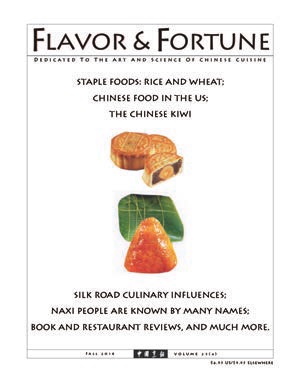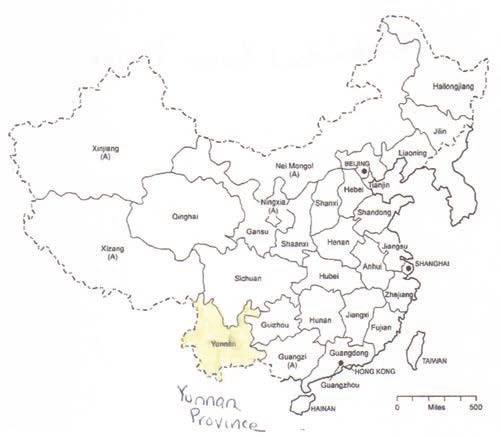|
Read 12904883 times
Connect me to:
|
TOPICS INCLUDE: Spanish Speakers, Hawaii, Minorities, Loofah, Mushrooms, Exclusion Acts, ReviewsLetters to the Editor
Spring Volume: 2019 Issue: 26(1) pages: 5 to 6
Editor:
This is for your 100th issue; and the question is: My
American minority friends are Spanish-speaking,
some Black, others Asian and Pacific Islanders, some
called Spanish-X; all are minorities in China. What
do the Chinese call them?
Garcia, White, and Lin: The largest,
according to the most recent Chinese 2010 census report,
the Han are the largest ethnic group who once were a
mixed ethnic population hundreds of years ago. The
next nine the government says are members of their
country’s fifty-five ethnic populations are in decreasing
order, most to least, they are Zhuang, Hui, Manchu, Miao,
Uyghur, Yi, Tujai, Tibetan, and Mongol populations; then
Dong, Bouyei, Yao, Bai, Koreans, Hong, Li, Kazak, Dai, and
She populations, and following them are Lisu, Dongxiang,
Gelao, Lahu, Va, Shui. Naxi, Qiang, Tu, and Mulao people.
The smallest group are Tartars, followed by those growing
in size: Lhoba, Gaoshan, and Hezhan. There are, you can
see, no Hispanics with or without an X. 
Hannah in Hawaii says:
Loved the goose and duck articles and the entire
super issue with great recipes for preserved eggs
which we never tried before but will now.
An wen: Your state has the sixth largest Chinese
population so finding where to purchase them should
be no problem. The largest Asian populations are in
California, Texas, New York, New Jersey, and Illinois. In
Chinese markets in all of them you can purchase duck
eggs, tongues and other popular Chinese delights. 
Min Lum:
Did check the web and Chinese minority information,
but it was in short supply, particularly for those
living in the Yunnan Province. What groups are they?
Sir: Read the answer to the above response; overall,
the last data we saw said Chinese minorities in that
province are about one-third. The Yi are the largest
ethnic group followed by the Bai, Hani, and Dai in that
order. Each have more than one million people, then
between half million and a million each are the Lisu, Va,
and Jingpo. The Jinu have eighteen thousand people in
Yunnan. The Va are one of China’s oldest minorities.
Their men wear red or black cloths around their head,
their women wear lots of silver jewelry. And yes, girls do
comb the hair of boys they fancy, and they sing to them.
If they like each other, he can spend a night at her home
but no sex as it is forbidden before marriage. JMN:
Just got the Fall issue; “it is a doozey, chockablock
with good stuff, minority info, duck tongue recipes,
and more”. Thanks to you.
HS: You and others do appreciate it; so we thank you all
for telling us so. Editor Newman:
Can you advise about loofah and its relatives? I do
love that member of the squash family but know little.
Lucille: We also love those Curbitaceae. Why are
their names different botanically? There are two large
varieties of loofah, both climbing gourds, both originating
in Asia, not all in China. The earliest grew in China’s
south, such as in Guangdong in the 6th century CE. The
angle one you wrote about has nine to eleven ridges and
is the most popular family member, Luffa acutangula
from the Guangdong Province growing there about one
hundred years. Did you know it flowers at sunset? Its
closest relative is short and spotted, and we never saw it.
Another relative is Chieh-guo also known as Benicasa
hispida which many Chinese call ‘Mao gourd’ but no one
we spoke to knew why. One chap said it has been grown
in his province lots longer. The bottle gourd which some
call a calabash or trumpet gourd is botanically called
Lagenaria siceria. This information is from a volume
called The Vegetables that was edited by Liu Zizhu and
Zhang Hua, its ISBN 978-7-5359-6512-7, its copyright is
2016. From Wong Hi:
You have written about mushrooms before, but please
share more about those that are healthy.
Wong: We are not doctors, not experts in TCM, nor in
healthy mushrooms, but we did ask several that are. Here
is some general health information from them and our
mushroom pile. We know to keep all of them cool and in
paper bags to reduce their spoilage. We do not wash any
of them, do remove dirt with a soft brush or damp cloth.
Straw mushrooms, botanically Volvariells volvorea,
are mostly grown in sub-tropical regions, they love damp
soil and do help reduce cancer.
Shiitake grow on decaying wood, particularly
chestnut, oak, beech, poplar, mulberry, and other broadleaf
hardwoods. They are revered in China and all of Asia,
are loved as food and medicine, and are tumor-inhibitors,
some are immuno-simulators.
Oyster mushrooms are Pleurotus ostreatus; they
are found in many colors, their texture resembles their
namesake, and medicinally, they benefit cardiovascular and
cholesterol-causing issues.
Portabella, Crimini, and Baby Bella
are Agaricus bisporus, cousins of white button
mushrooms best picked with closed veils. They are good
for breast cancer and coronary heart diseases.
Maitake are Grifola frondosa and known as the
‘Hen of the Woods’ mushroom. They have a central stalk,
positively impact some cancers and reduce high blood
pressure and high cholesterol.
Enoki are Flammulina velutipes mushrooms that
can contain anti-tumor substances to reduce cancers.
Pom pom mushrooms are Hericium crinaceus
known to reduce stomach, digestive, and nervous
system disorders.
Beech mushrooms are Hypsizygus tessulatus with
strong anti-oxident activity.
Wood Ear and cloud ear mushrooms are
Auriculari polytricha, and they reduce heart problems. Newman please:
Were the Exclusion Acts targeted only for the
Chinese?
Sue Lee: One brochure at the Stony Brook University
Wang Center says “For sixty-one years Chinese people
were barred from immigrating to the US and denied
citizenship. These Exclusion Laws were eventually
expanded to bar all Asians.” The illustration in its
brochure does show an early picture of Chinese and
does tout they were not specifically just for the Chinese. Editor:
Can you advise about the contents of: ‘An
Introduction to Chinese Food Culture?’ The ISBN
number I have seems incorrect?
Lou: The correct ISBN is 978-7-04049451-8, and this
book costing 49.80 Yuan is published in China, its cover
in English and Chinese. The text is 100% Chinese. To one of your editors:
How old are the exclusion laws?
To your question: Read above and do see
a fine film with answers to this and its food-related
questions. The answer needs more space than we
have. Do check with Netflix and other sources for the
story behind this 1882 law, and do see the question
and response above and more about issues for Asians
including immigration, globalization, civil rights, etc.
explored in it. Newman:
Will you be reviewing the ‘An Introduction to Chinese
Food Culture’ book you were given at the 8th Asian
Food Culture Meeting?
Bing: Sorry to disappoint you, but as it is all in
Chinese, and I can not read or speak this language
which I did try to do three times but was a failure so
doing. |



